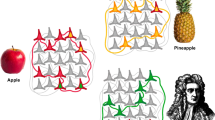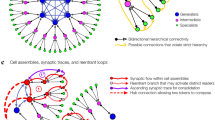Summary
It is discussed whether information-processing or connectionist models might explain the law ofPrägnanz under constraints resulting from a physical interpretation of these models. An information-processing approach is contrasted with thermodynamics and, finally, an alternative approach more directly inspired by Gestalt is discussed. It is argued that this model could be physically realized with relatively moderate requirements on the substrate in terms of information-processing resources.
Similar content being viewed by others
References
Buffart, H. (1986). Gestalt qualities, memory structure, and minimum principles. In F. Klix & H. Hagendorf (Eds.),Human memory and cognitive capabilities (pp. 189–204). Amsterdam: North Holland.
Dretske, F. (1983). Précis of Knowledge and the Flow of Information.Behavioral and Brain Sciences, 1, 55–63.
Epstein, W. (1988). Has the time come to rehabilitate Gestalt theory?Psychological Research, 50, 2–6.
Gottschaldt, K. (1929). Über den Einfluß der Erfahrung auf die Wahrnehmung von Figuren: II.Psychologische Forschung, 12, 1–87.
Guthke, J., Räder, E., Caruso, M., & Schmidt K.-D. (1990). Entwicklung eines adaptiven computergestützten Lemtests auf der Basis der strukturellen Informationstheorie.Diagnostika, (in press).
Hendler, J. A. (1989). Marker-passing over micro-features: Towards a hybrid symbolic/connectionist model.Cognitive Science, 13, 79–106.
Henle, M. (1984). Isomorphism: Setting the record straight.Psychological Research, 46, 317–327.
Hinton, G. E., & Sejnowski, T. J. (1986). Learning and relearning in Boltzmann machines. In D. E. Rumelhart & J. L. McClelland (Eds.),Parallel distributed processing. Cambridge, MA: MIT Press.
Krause, W. (1989). Über menschliches Denken — Denken als Ordnungsbildung.Zeitschrift für Psychologie, 197, 1–30.
Leeuwen, C. van (1989). PDP and Gestalt, an integration?Psychological Research, 50, 199–201.
Leeuwen, C. van (1990). Indeterminacy of the isomorphism heuristic.Psychological Research, 52, 1–4.
Leeuwen, C. van, & Buffart, H. (1989). Facilitation of retrieval by perceptual structure.Psychological Research, 50, 202–210.
Leeuwen, C. van, Buffart, H., & van der Vegt, J. (1988). Sequence influence on the organization of meaningless serial stimuli: Economy after all.Journal of Experimental Psychology: Human Perception and Performance, 14, 481–502.
Leeuwen, L. van, & Smitsman, A. (1991). Perzeption von Handlungsmöglichkeiten und die Entwicklung von Werkzeuggebrauch im frühen Kindesalter. In F. J. Monks & G. Lehwald (Eds.),Exploration, Kompetenz, Begabung. Beiträge zur frühkindlichen Entwicklung. München: Reinhardt (in press).
Leeuwenberg, E. (1971). A perceptual coding language for visual and auditory patterns.American Journal of Psychology, 84, 307–349.
Luchins, A. S. (1942). Mechanization in problem solving: The effect of “Einstellung”.Psychological Monographs, 54, (Whole No. 248).
Maas, H. L. J. van der, Verschure, P. F. M. J., & Molenaar, P. C. M. (1990). A note on chaotic behavior in simple neural networks.Neural Networks, (in press).
Newell, A. (1980). Physical symbol systems.Cognitive Science, 4, 135–183.
Nicolis, J. S., & Prigogine, I. (1977).Self-organization in non-equilibrium systems: From dissipative structures to order through fluctuations. New York: Wiley.
Pribram, K. (1984). What is iso and what is morphic in isomorphism?Psychological Research, 46, 329–332.
Prigogine, I. (1980).From being to becoming: Time and complexity in the physical sciences. San Fransisco: Freeman.
Pylyshyn, Z. W. (1984).Computation and cognition. Cambridge, MA: MIT Press.
Rock, I. (1983).The logic of perception. Cambridge, MA: Bradford Books.
Rosenberg, J. (1990). Treating connectionism properly: Reflections on Smolensky.Psychological Research, 52, 163–174.
Scheerer, E. (1978). Expansion of the functional visual field and context skipping in a continuous search task.Psychological Research, 40, 113–126.
Thom, R. (1985). From the icon to the symbol. In R.E. Innes (Ed.),Semiotics, an introductory anthology (pp. 275–291). London: Hutchinson.
Van der Vegt, J., Buffart, H. J. F. M., & van Leeuwen, C. C. (1988). The “structural memory”: A network model for human perception of serial objects.Psychological Research, 50, 211–222.
Wulf, F. (1922). Über die Veränderung von Vorstellungen.Psychologische Forschung, 1, 333–373.
Author information
Authors and Affiliations
Rights and permissions
About this article
Cite this article
van Leeuwen, C. Perceptual-learning systems as conservative structures: Is economy an attractor?. Psychol. Res 52, 145–152 (1990). https://doi.org/10.1007/BF00877522
Issue Date:
DOI: https://doi.org/10.1007/BF00877522




